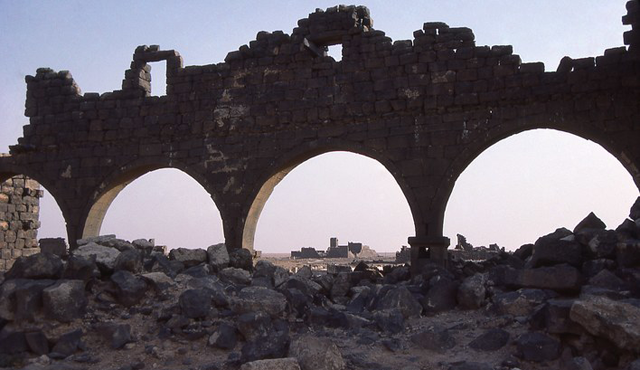AMMAN — In 1996, a team of archaeologists discovered a Greek inscription in the tomb near the village of Dafyana, in northern Jordan, located around 22 kilometres east of Umm Jimal. The stele was taken to the Mafraq museum and it was concluded by the researchers that the tomb was looted. The epitaph on the tomb provides information about a deceased individual who lived in Dafyana.
The inscription states: “Here, for the first [time], was buried Bennis, the son of Germanus, officialis of the governor, having died in [the province of] Diospontus. He was transported [here] by Sisinnios [his] household servant/slave in the year 312/313 AD, after having lived 22 years.”
“There is no indication that the burial represents a family tomb; no other family member is attested in the epitaph and no epigraphic evidence exists about a surviving family member of the 22-year-old Bennis at the ‘monumental’ tomb. The other three smaller vaults appear to be for women,” the scholar David Graf, from The University of Miami, outlined.
“We therefore prefer to understand this expression to mean that Bennis was not buried in Diospontus where he died, but he was transported [his corpse, skeleton, or cremated remains] to the Hawran to be buried there,” Graf explained,
According to Graf, the name “Bennos” also appears once in Emesa (modern Homs) in Syria and both of these Greek-spelled names, Benis and Bennos, have been generally understood as reflecting or transcribing the Semitic names.
Furthermore, the name Bny appears in Nabataean Aramaic and is common in early North Arabian, presumably derived either from bny, “to build”, or from a diminutive for “little son”.
As a result, Graf continued, the Semitic context provides a plausible explanation for the name Bennis in the text.
The Latin form of the name seems to clearly be at stake in a Greek text from the sanctuary complex at Sfire, east of Tripoli in northern Lebanon, where the artisans of a temple constructed in 283/284 AD are listed as “Gaius kai Benni kai Ponpliou”.
“The same Latin name seems to be at issue in a text from the Wadi Hammamat in Egypt that mentions a Gaios Benios Keler, a soldier of the Cohors I Flavia Cilicum equitata during the reign of Emperor Domitian [AD 81–96], and a Loukion Benion from the Acropolis in Athens,” Graf explained, adding that it is then entirely possible that Bennis is just an apocopated form of the Latin Bennius.
If this is the case, Bennis of the Dafyana epitaph may be identified with the son of a Roman soldier serving in the region.
There is also another speculation for the name Bennis, as it can be associated with the Anatolian cult of Zeus Bennios, since the deceased had resided in Pontic Cappadocia.
“The cult of Zeus Bennios is attested throughout northwest Phrygia, primarily in the Upper Tembris Valley.
But outside this geographic zone, only two attestations of the cult are known, one in the northeast of Krateia, in the extreme east of Bithynia towards Paphlagonia in Phrygia Epictete, and the other in the village Ahmetler, 50 kilometres northwest of Eskişehir on the Phrygia-Bithynian border,” Graf explained, adding that the concentration of these attestations suggest the cult of Zeus.
The concentration of these attestations suggests that the cult of Zeus Bennios was restricted to the regions of Phrygia and Galatia, the scholar underlined, adding that the possibility that our name Bennis was derived from the Phrygian cult seems rather unlikely.
“There is no evidence that the cult penetrated Pontus and Cappadocia several hundred kilometres further east, making it highly unlikely that our name Bennis reflects an adherent of the Phrygian cult,” Graf concluded.
